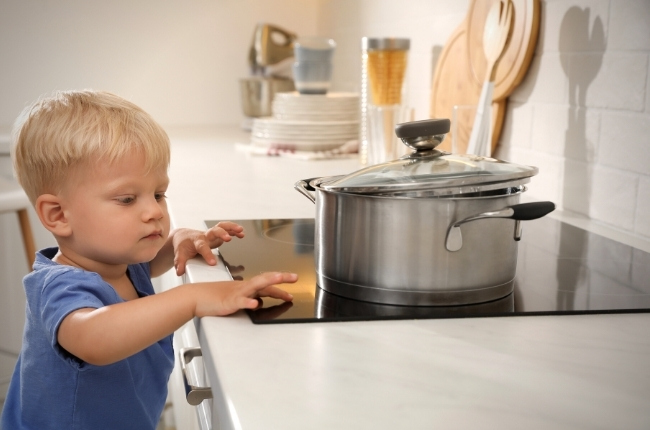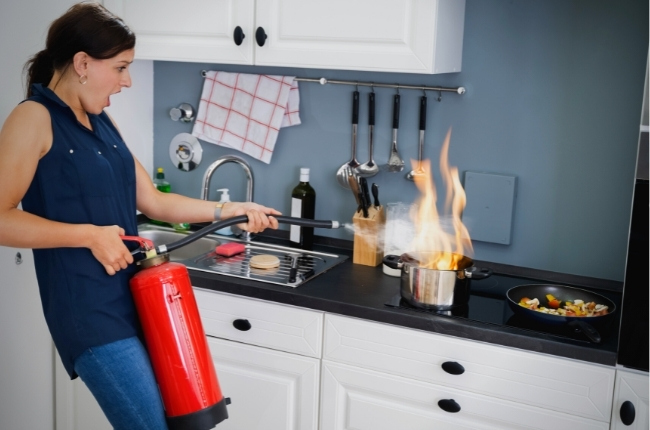You already have an induction cooktop at home. After using it a few times, you notice that the cooktop gets warm somewhere.
Maybe on the surface? Or on the underside?
Either way, it is concerning for induction cooktops to heat up. That is probably what brought you to this article.
We assure you that your worries are valid, and we commend you for spotting a red flag early.
In this article, we will tell you about situations when it is normal or not normal for an induction cooktop to get hot. We also cover topics on what to do in case your induction stove gets abnormally hot and other safety concerns related to fires and burns.
Does the surface of an induction cooktop get hot?
Typically, most parts of the surface of an induction cooktop remain cool even while cooking.
This is because the electromagnetic technology present in induction cooktops transfers heat directly to the cookware. Hence, the cooktop surface does not heat up anymore.
Do induction cooktops get hot to touch?
As mentioned earlier, induction cooktops remain cool because they do not transfer heat via conduction the way gas burners and electric cooktops do.
A great advantage of induction cooktops is that they are safe for children, the elderly, and pets. Even if your toddler accidentally reaches out to your cooktop while you are cooking, they will not get burned.

But you might have a different experience, so you might ask: “Why is my induction cooktop hot to the touch?”
Before telling you the possible defects of your cooktop, let us first discuss the few scenarios where it is normal for an induction cooktop to get hot.
Remember that you are probably using iron pans on induction cooktops. Iron pans are good conductors of heat and energy, which is precisely why they work great on induction.
Since these pans essentially store heat, they can also transfer heat to any conductive material they are directly in contact with.
Glass-ceramic, the material that your cooktop’s surface is made of, is conductive enough to absorb direct heat from the iron pans. But not so much that it spreads heat to other areas.
As a result, the only part of your induction cooktop that gets hot when cooking is the area directly covered by the cookware. Since glass-ceramic cannot spread heat, everywhere else that the cookware does not touch will not heat up.
Are induction burners cool to the touch?
Unlike electric and gas stoves, induction cooktops do not have “burners”. What they do have is a cookware alignment guide.
The cookware alignment guide is the white circle drawn on the surface of the cooktop. This line tells you where to put your pans so that the electromagnet can successfully detect them.
The cookware alignment guide resembles the “burner” part of electric cooktops and gas stoves.
So, do they heat up, or do they remain cool?

When you cook, the cookware heats up and transfers heat to the area directly underneath it. Hence, if your cookware is within the prescribed circle, then the area within that circle will also heat up.
After cooking, the heated area will remain warm for a few minutes. So this is the part where you should be cautious.
But don’t worry, it will quickly cool down because glass ceramics are not good conductors of heat.
Also, induction cooktops have fans on the inside, which help cool down the cooktop surface and the parts underneath it.
Further, if the cooktop is not operating, the whole induction burner will remain cool to the touch.
If the cooktop is ON, but there is no induction-compatible cookware or anything that can absorb electromagnetic energy on top of it, then the cooktop surface will remain cool.
Why is my induction cooktop hot to the touch?
Let us go back to the possible defects of your induction in case it gets too hot to touch.
Unfortunately, despite all the promising safety claims of induction cooktops, some users report excessive overheating of their induction cooktop surface, including the touch buttons. Although it usually only happens when they use all four burners simultaneously.
We all know this is not supposed to happen with how induction cooktops work.
Even if all four burners work at the same time, the heat should only be concentrated on the bottom of the four pans. Heat should not reach the in-between of the pans. More importantly, it should not reach the touch buttons.
If this happens to you, you must get your induction cooktop checked by a technician immediately.
Does the bottom of an induction cooktop get hot? Yes, and it can possibly cause overheating. We will cover that later.
In the meantime, only expert technicians can give a conclusive diagnosis as to why such overheating happens. But here is our guess: maybe your induction cooktop’s built-in ventilation is faulty.
Before elaborating on this problem, let us first discuss what happens under the induction cooktop surface.
Do the underside of induction hobs get hot?
Yes, the underside of induction cooktops gets hot because of the residual heat from the bottom of the heated cookware.
As previously mentioned, the heated cookware heats the glass-ceramic surface with which it comes in contact. The heat does not spread on the glass. Instead, it goes through it, heating the opposite side of the glass.
This heat can be trapped under the surface. Thankfully, most induction cooktops have a built-in ventilation system which is mainly a couple of ventilation holes and fans.
I know what you’re thinking: “If that is the case, then why does my induction cooktop get hot?”
If the ventilation system is faulty, the residual heat from the pans can heat up the electronic parts inside the cooktop. Hence, resulting in overheating.
Most induction stoves automatically turn off upon detecting excessive heat. If that’s not the case for you, then your induction might be defective.
If your induction cooktop is just warm, not hot, consider opening the drawer under the cooktop when you feel the surface warming up. This is to give the heat more room to escape.
Also, ensure that you follow the required gap between the bottom of the induction cooktop and the material under it. Some brands require a 12-inch gap, while others only need 3 inches.
Check if you have magnetic materials in your drawers that may also generate heat from the electromagnet. If you find one, place them somewhere else, as these can also contribute to overheating.
Can you burn yourself on an induction cooktop?
Induction cooktops only heat up ferrous (i.e., iron-rich) materials. Unless you have metal hands, touching a perfectly functioning induction cooktop surface should not be a problem.
If your induction cooktop is overheating, however, of course, you can burn yourself if it is hot enough. If you’re not careful, touching the heated cookware can injure you.
Can induction cooktop cause fire?

It is very hard to cause a fire with an induction cooktop. Other users put paper towels between their cookware and the cooktop surface to prevent scratching the surface.
Technically, combustible materials, such as paper towels, can start a fire when put under extremely high temperatures. But no induction cooktop can generate enough heat, and no heated cookware can conduct enough heat to set a paper towel on fire.
However, you may opt for silicone pads or cloth towels instead to be safer. Since they are much less combustible than paper towels, they are less likely to catch fire.
Can you burn food on an induction cooktop?
Induction cooktops react quickly to temperature changes.
Sometimes, it is the cookware that cannot keep up. Materials like cast iron heat up very quickly but cool down slowly. So, even if you change your induction’s setting to low, the cast iron’s temperature will take time to adjust.
That’s what makes it possible to burn food while cooking on an induction cooktop. When cooking with induction, you must be mindful about what pans you use and how you use them to avoid unpleasant situations like burning food.
However, if you are pertaining to burning food on the cooktop surface, then that would be a different answer.
If you spill sauce, for example, on the cooktop surface, it won’t burn and crisp up like it would on gas and electric stoves.
Since the induction cooktop surface remains cool, the spilled sauce will not burn on it. You can easily wipe it off with a damp towel after the burner cools down. You see, easy cleaning is another benefit of induction cooktops.
Takeaway
Induction cooktops that work properly should not heat up on parts that the cookware doesn’t touch. Warm surfaces and undersides are to be expected, especially right after cooking.
But if you notice that the cooktop surface is hot enough to burn your finger and if the touch buttons and underside are hot too, then it is time to consult a technician.

Leave a Reply